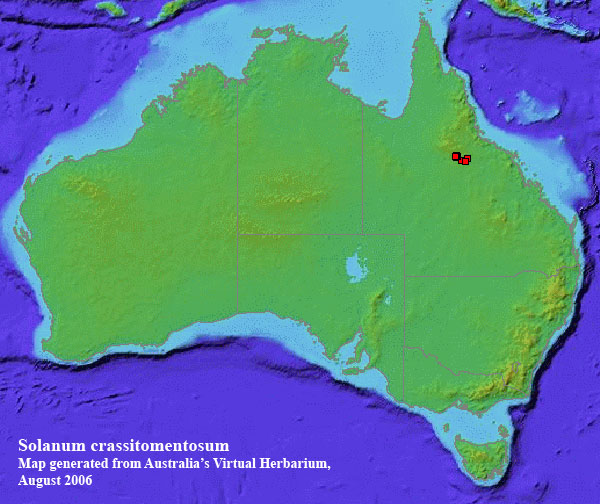
Synonymy
Solanum crassitomentosum Domin, Biblioth. Bot. 89: 584 (1929).
T: Qld, Dividing Range W of Pentland, Feb 1910, K.Domin s.n.; holo: PR530902.
Solanum quadriloculatum auct.non F.Muell.; Symon, J.
Description
Erect, rhizomatous perennial shrub, 0.3-1 m high. Juvenile stage unknown. Adult stems bark furrowed, corky. Adult branchlets terete or ridged, yellow or rusty or brown; prickles 30-160 per decimetre, straight, acicular, 1-5 mm long, 10-16 times longer than wide; stellae very dense, 0.25-0.7 mm diameter, stalks 0-0.7 mm long; lateral rays 6-9, ascending; central ray 1-2 times as long as laterals, not gland-tipped; finger hairs absent; Type 2 hairs absent.
Adult leaves ovate or broadly ovate, entire; lamina 3.5-7.5 cm long, 1.5-3.5 cm wide, 1.7-2.3 times longer than broad, apex acute, base obtuse or cordate, oblique part 0-3 mm long, obliqueness index 0-6 percent; petioles 0.8-2.6 cm long, 16-35% length of lamina, prickles absent or present. Upper leaf surface grey; prickles absent; stellate hairs distributed throughout; proto-stellae absent; ordinary stellae very dense, c. 0.05 mm apart, 0.5-0.7 mm across, stalks 0-0.7 mm long; lateral rays 6-8, porrect; central ray 1.2-2.5 times as long as laterals, not gland-tipped; finger hairs absent; Type 2 hairs absent. Lower leaf surface white or yellowish; prickles absent; stellae dense to very dense, 0.05-0.1 mm apart, 0.4-0.8 mm diameter, stalks 0-1 mm long; lateral rays 7 or 8, porrect; central ray 1.5-2 times as long as laterals, not gland-tipped; finger hairs absent; Type 2 hairs absent.
Inflorescence leaf-opposed, solitary or pseudo-racemose, common peduncle 5-14 mm long, rachis prickles absent; 1 or 2-flowered, strongly or weakly andromonoecious, flowers 5-merous; pedicels 4-11 mm long at anthesis, same thickness throughout or markedly thicker distally, 1.1-1.5 mm thick at mid-point, prickles absent. Calyx tube 3.5-5 mm long, lobes deltate, 4-7 mm long; prickles absent at anthesis; stellae very dense, transparent or brown or rusty, 0.5-0.7 mm across, stalks 0.3-0.9 mm long, lateral rays 7 or 8, central ray 1-2 times as long as laterals, not gland-tipped; finger hairs absent; Type 2 hairs absent. Corolla white, mauve or purple, 12-17 mm long, shallowly or deeply lobed, inner surface densely stellate-hairy; anthers 5.5-7.5 mm long; ovary glabrous, or with Type 2 hairs only; functional style 10.5-12.5 mm long, erect, glabrous.
Fruiting calyx with lobes less than or more than half length of mature fruit, prickles absent. Mature fruits 1 per inflorescence, globular, 14-18 mm diameter, yellowish-green or green, 4-locular; placenta in cross-section stalked, circular to elliptical; mesocarp moist but not juicy; exocarp 2.4-3 mm thick; pedicels 7-13 mm long in fruit, 1.3-1.5 mm thick at mid-point; seeds brown to black, 2.5-2.8 mm long.
Reproduced, with permission, from Bean (2004).
Another detailed description of this species can be found on the Bean interactive key site at http://delta-intkey.com/solanum/www/crassito.htm
Distribution and ecology
Occurs only in the White Mountains to Burra Range area, near Townsville, Qld. Found on sandstone in eucalypt woodland.
Relationships
Considered by Bean (2004) to be a member of the S. ellipticum group of subgen. Leptostemonum.
Selected specimens
QLD: BURKE DISTRICT: ‘Warang’ area, White Mountains N.P., Apr 2000, McDonald KRM385 (BRI); NW of ‘Warang’, White Mountains N.P., Apr 2000, McDonald KRM467 (BRI); 20 km W of ‘Warang’ HS site, White Mountains N.P., 57 km by road N of Torrens Creek, Apr 2000, Thomas 1835 & Thompson (BRI, NSW); 3 km NW of ‘Warang’ HS site, White Mountains N.P., Apr 2000, Thomas 1840 & Thompson (BRI, NSW). NORTH KENNEDY DISTRICT: W of Pentland, between Warrigal and Burra, Oct 1935, Blake 9921 (BRI);
Specimens cited by Bean (2004).
Plant status, if any
Currently known from only 4 locations, all within the White Mountains National Park, Qld. It is not considered to be at risk (Bean 2004).
From the web
Further information and links for this species can be found on the Solanaceae Source site.
A fact sheet describing the vegetation types occupied by this species can be found at www.epa.qld.gov.au/media/nature_conservation/biodiversity/desert_uplands/Factsheets/101001.htm and www.epa.qld.gov.au/media/nature_conservation/biodiversity/desert_uplands/Factsheets/100501.htm